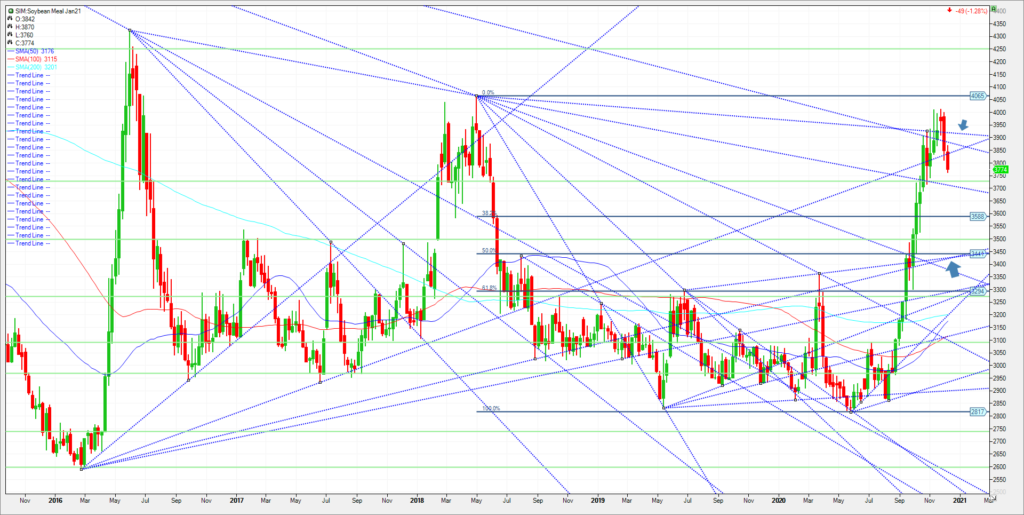Commentary
Perhaps the fear for the soybean shorts into Thursdays USDA WASDE crop report is that a further cut in ending stocks for soybeans near 100 million bushels down from last month’s 190 million would result in a sizable rally. The recent highs at 12.00 could be eventually be surpassed and that new highs are seen in beans and meal should we get bullish report day data. In my view profit taking amid long liquidation has been the theme so far in December as Chinese bean demand has waned in recent weeks. The hot/dry drought like conditions in South America have been somewhat priced in so far, albeit its early as the planting pace is now over 90 percent planted in Brazil and above 50 percent in Argentina.
The latest USDA data shows that exporters sold 1.923 billion bushels of soybeans through November 26, or essentially the end of the first quarter of the marketing year. That equates to 87% of USDA’s 2.200 billion-bushel target for the year. That is 410 million bushels above the seasonal pace needed to hit USDA’s target for the year. The question for me is has the insatiable demand pace been factored into USDA’s 2.200 billion-bushel export target? Or will they raise it in this report or in the January report knocking down ending stocks to levels not seen since 2012. Finally, could USDA’s crush estimate also inch higher, based on the pace we’ve seen thus far, and on lingering political, economic and weather problems in Argentina that reduce its available supplies. The average trade guess heading into Thursdays 11am report for soybean ending stocks is at 168 million bushels. The range is (120-190). Last month we came in at 190.
I’m watching meal longer term as dips in that market seem like buying opportunities to me if a Strong La Nina exists into Jan /Feb timeline into 2021. Argentina is the biggest bean crusher in the World and given a short crop there on top of the short supplies in ending stocks here in the US, one could posit a short squeeze potentially down the road. On the other hand, given what I’m seeing currently on the charts, a close under 371 could push the market to 3.58 and then 3.44 eventually. Therefore I am proposing a strangle in the market using near term options for downside exposure and using any dip in the market to buy a call spread long term. Chart and game plan to follow.

Trade Idea-
Futures-N/A
Options-For downside, buy the Feb 350 soymeal put for 1.50 OB. Cost is $150.00 plus commissions and fees. For upside buy the July 21 4.50/5.00 call spread for 3 points or $300.00 plus commissions and fees.
Risk/Reward
Futures-N/A
Options- The cost and risk of buying both the outright put (Feb 21 350P) and call spread (SMN21 4.50/5.00) is $450.00 plus commissions and fees if filled at the prescribed levels. In my view liquidate the put on a close in March meal over 3.90. I would exit the call spread at on a close under 3.44 basis July 21 futures. Call me with questions. Note: this is just one way in my view to play this market, not THE way. I have other ideas into Thursdays report and beyond using futures, and futures spreads. My point here is to establish positions for relatively low cost and risk in both directions because in my view I don’t see prices stabilizing here for long. Just my opinion.
Please join me for a free grain and livestock webinar every Thursday at 3pm Central. Sign up is free and a recording link will be sent upon signup. We discuss supply, demand, weather, and the charts. Sign Up Now
Walsh Trading, Inc. is registered as a Guaranteed Introducing Broker with the Commodity Futures Trading Commission and an NFA Member.
Futures and options trading involve substantial risk and is not suitable for all investors. Therefore, individuals should carefully consider their financial condition in deciding whether to trade. Option traders should be aware that the exercise of a long option will result in a futures position. The valuation of futures and options may fluctuate, and as a result, clients may lose more than their original investment. The information contained on this site is the opinion of the writer or was obtained from sources cited within the commentary. The impact on market prices due to seasonal or market cycles and current news events may already be reflected in market prices. PAST PERFORMANCE IS NOT NECESSARILY INDICATIVE OF FUTURE RESULTS.
All information, communications, publications, and reports, including this specific material, used and distributed by Walsh Trading, Inc. (“WTI”) shall be construed as a solicitation for entering into a derivatives transaction. WTI does not distribute research reports, employ research analysts, or maintain a research department as defined in CFTC Regulation 1.71.
